Business Research Approaches and Scenario Based Analysis
VerifiedAdded on 2023/06/10
|6
|1121
|351
AI Summary
This article discusses the two paradigms used in business research, namely positivist and constructivist approaches. It compares the differences between the two and their limitations. Additionally, it provides an example of how to apply the quantitative research approach in a given scenario. The article cites references from Fellows & Liu (2015) and Yilmaz (2013).
Contribute Materials
Your contribution can guide someone’s learning journey. Share your
documents today.
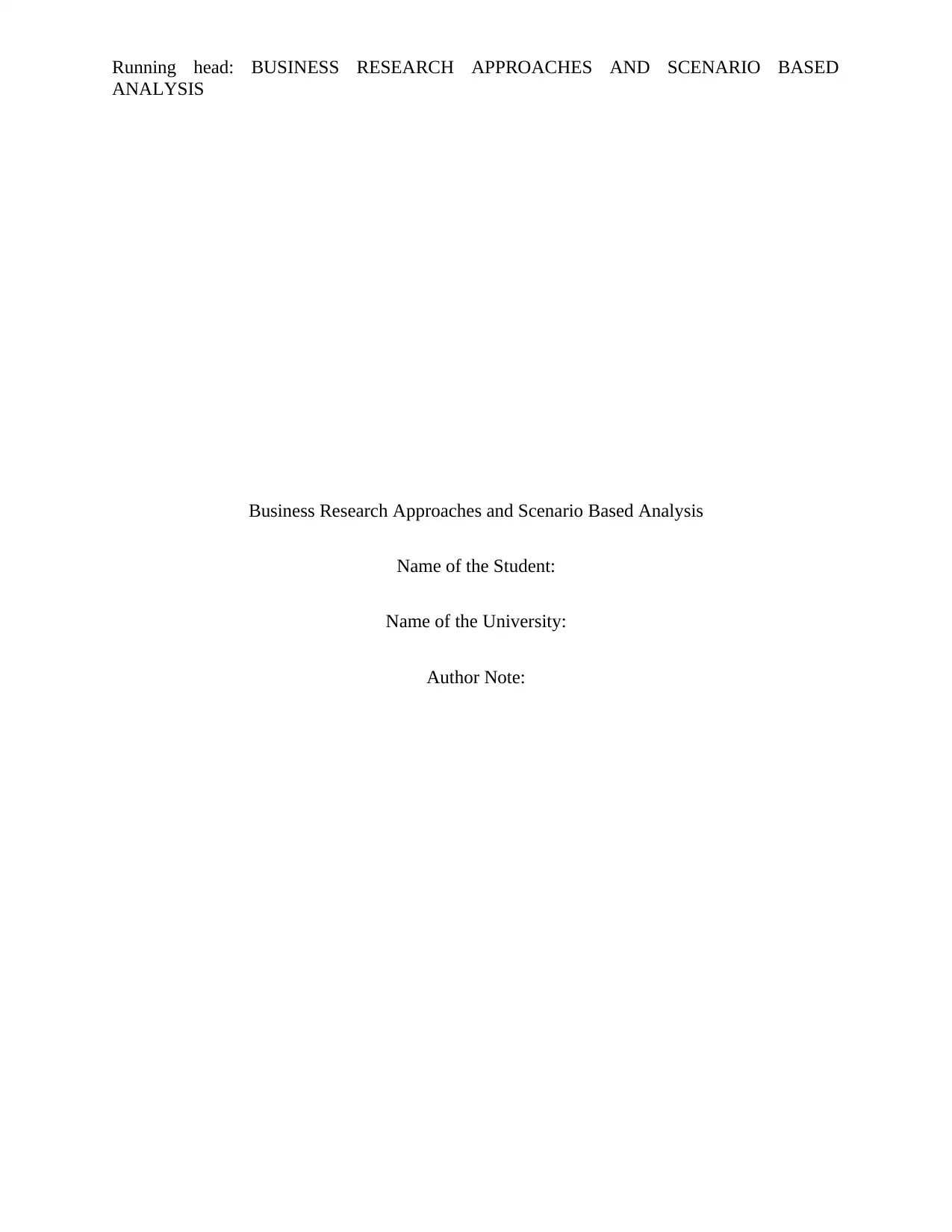
Running head: BUSINESS RESEARCH APPROACHES AND SCENARIO BASED
ANALYSIS
Business Research Approaches and Scenario Based Analysis
Name of the Student:
Name of the University:
Author Note:
ANALYSIS
Business Research Approaches and Scenario Based Analysis
Name of the Student:
Name of the University:
Author Note:
Secure Best Marks with AI Grader
Need help grading? Try our AI Grader for instant feedback on your assignments.
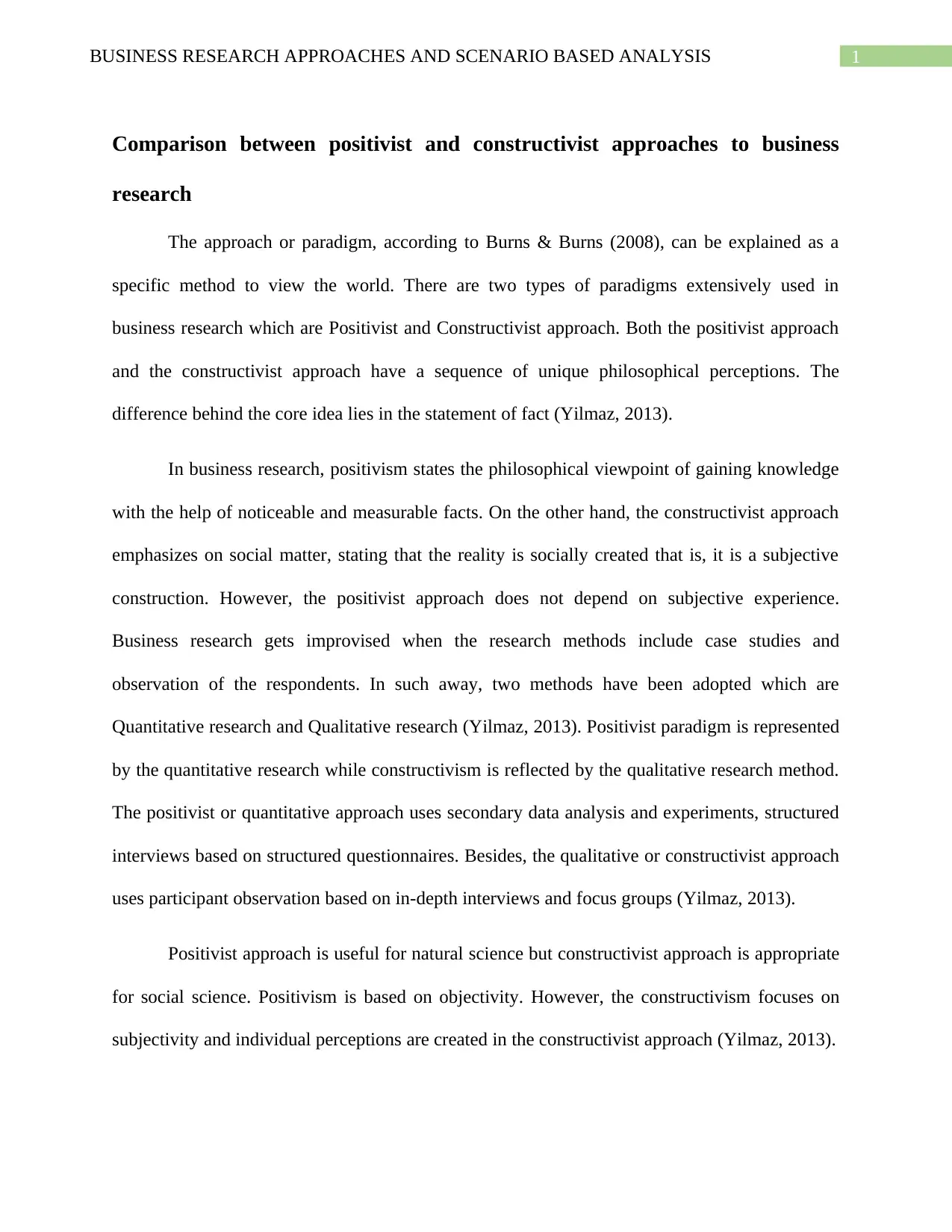
1BUSINESS RESEARCH APPROACHES AND SCENARIO BASED ANALYSIS
Comparison between positivist and constructivist approaches to business
research
The approach or paradigm, according to Burns & Burns (2008), can be explained as a
specific method to view the world. There are two types of paradigms extensively used in
business research which are Positivist and Constructivist approach. Both the positivist approach
and the constructivist approach have a sequence of unique philosophical perceptions. The
difference behind the core idea lies in the statement of fact (Yilmaz, 2013).
In business research, positivism states the philosophical viewpoint of gaining knowledge
with the help of noticeable and measurable facts. On the other hand, the constructivist approach
emphasizes on social matter, stating that the reality is socially created that is, it is a subjective
construction. However, the positivist approach does not depend on subjective experience.
Business research gets improvised when the research methods include case studies and
observation of the respondents. In such away, two methods have been adopted which are
Quantitative research and Qualitative research (Yilmaz, 2013). Positivist paradigm is represented
by the quantitative research while constructivism is reflected by the qualitative research method.
The positivist or quantitative approach uses secondary data analysis and experiments, structured
interviews based on structured questionnaires. Besides, the qualitative or constructivist approach
uses participant observation based on in-depth interviews and focus groups (Yilmaz, 2013).
Positivist approach is useful for natural science but constructivist approach is appropriate
for social science. Positivism is based on objectivity. However, the constructivism focuses on
subjectivity and individual perceptions are created in the constructivist approach (Yilmaz, 2013).
Comparison between positivist and constructivist approaches to business
research
The approach or paradigm, according to Burns & Burns (2008), can be explained as a
specific method to view the world. There are two types of paradigms extensively used in
business research which are Positivist and Constructivist approach. Both the positivist approach
and the constructivist approach have a sequence of unique philosophical perceptions. The
difference behind the core idea lies in the statement of fact (Yilmaz, 2013).
In business research, positivism states the philosophical viewpoint of gaining knowledge
with the help of noticeable and measurable facts. On the other hand, the constructivist approach
emphasizes on social matter, stating that the reality is socially created that is, it is a subjective
construction. However, the positivist approach does not depend on subjective experience.
Business research gets improvised when the research methods include case studies and
observation of the respondents. In such away, two methods have been adopted which are
Quantitative research and Qualitative research (Yilmaz, 2013). Positivist paradigm is represented
by the quantitative research while constructivism is reflected by the qualitative research method.
The positivist or quantitative approach uses secondary data analysis and experiments, structured
interviews based on structured questionnaires. Besides, the qualitative or constructivist approach
uses participant observation based on in-depth interviews and focus groups (Yilmaz, 2013).
Positivist approach is useful for natural science but constructivist approach is appropriate
for social science. Positivism is based on objectivity. However, the constructivism focuses on
subjectivity and individual perceptions are created in the constructivist approach (Yilmaz, 2013).
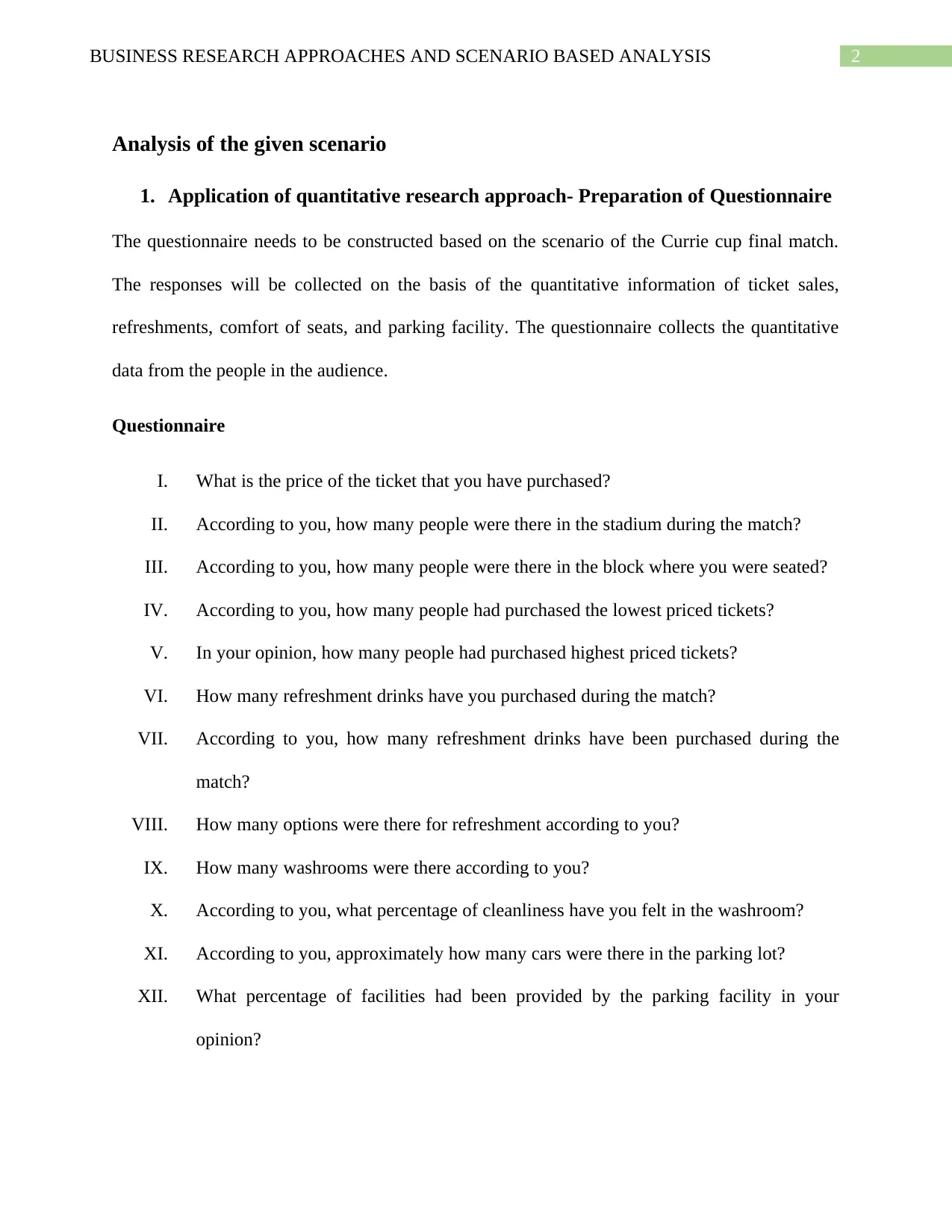
2BUSINESS RESEARCH APPROACHES AND SCENARIO BASED ANALYSIS
Analysis of the given scenario
1. Application of quantitative research approach- Preparation of Questionnaire
The questionnaire needs to be constructed based on the scenario of the Currie cup final match.
The responses will be collected on the basis of the quantitative information of ticket sales,
refreshments, comfort of seats, and parking facility. The questionnaire collects the quantitative
data from the people in the audience.
Questionnaire
I. What is the price of the ticket that you have purchased?
II. According to you, how many people were there in the stadium during the match?
III. According to you, how many people were there in the block where you were seated?
IV. According to you, how many people had purchased the lowest priced tickets?
V. In your opinion, how many people had purchased highest priced tickets?
VI. How many refreshment drinks have you purchased during the match?
VII. According to you, how many refreshment drinks have been purchased during the
match?
VIII. How many options were there for refreshment according to you?
IX. How many washrooms were there according to you?
X. According to you, what percentage of cleanliness have you felt in the washroom?
XI. According to you, approximately how many cars were there in the parking lot?
XII. What percentage of facilities had been provided by the parking facility in your
opinion?
Analysis of the given scenario
1. Application of quantitative research approach- Preparation of Questionnaire
The questionnaire needs to be constructed based on the scenario of the Currie cup final match.
The responses will be collected on the basis of the quantitative information of ticket sales,
refreshments, comfort of seats, and parking facility. The questionnaire collects the quantitative
data from the people in the audience.
Questionnaire
I. What is the price of the ticket that you have purchased?
II. According to you, how many people were there in the stadium during the match?
III. According to you, how many people were there in the block where you were seated?
IV. According to you, how many people had purchased the lowest priced tickets?
V. In your opinion, how many people had purchased highest priced tickets?
VI. How many refreshment drinks have you purchased during the match?
VII. According to you, how many refreshment drinks have been purchased during the
match?
VIII. How many options were there for refreshment according to you?
IX. How many washrooms were there according to you?
X. According to you, what percentage of cleanliness have you felt in the washroom?
XI. According to you, approximately how many cars were there in the parking lot?
XII. What percentage of facilities had been provided by the parking facility in your
opinion?
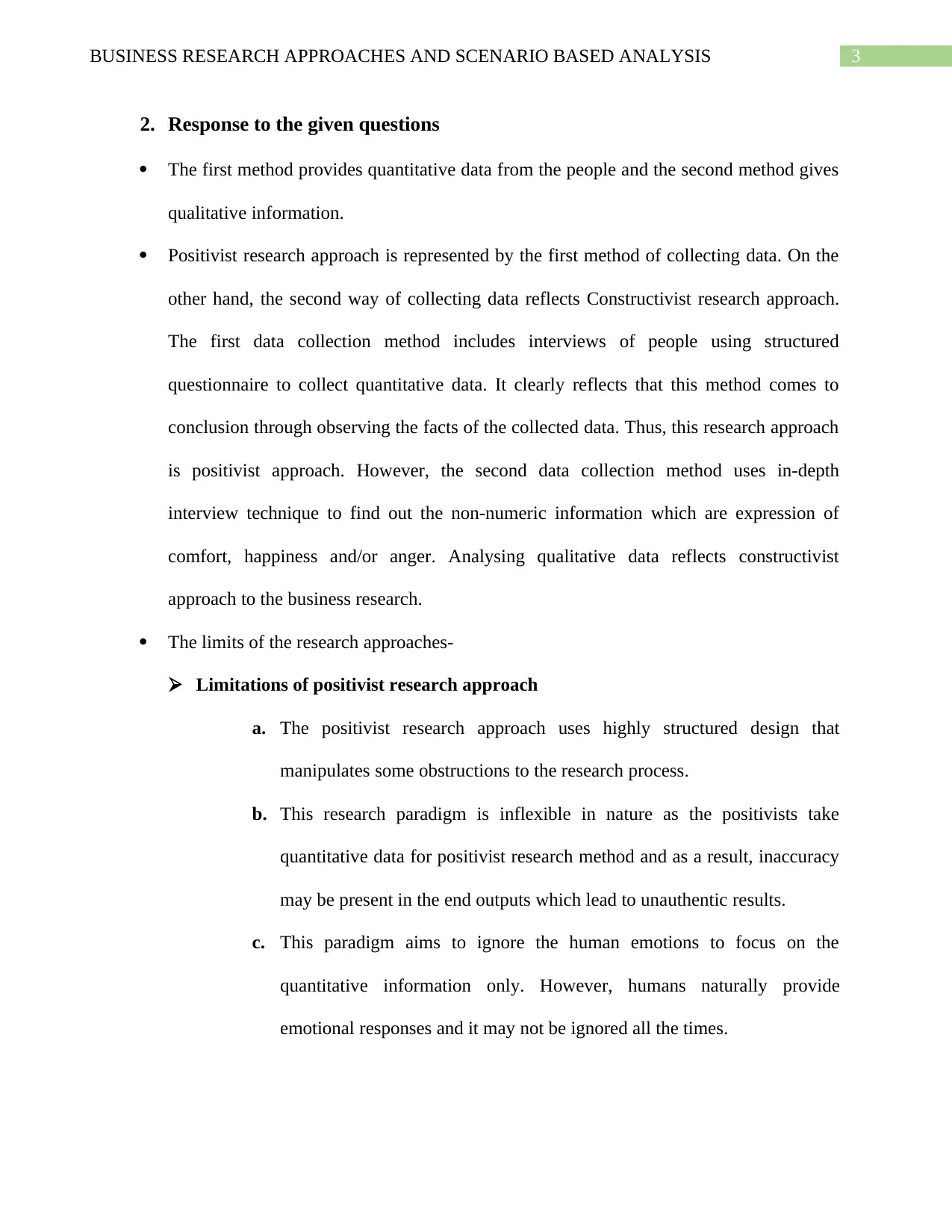
3BUSINESS RESEARCH APPROACHES AND SCENARIO BASED ANALYSIS
2. Response to the given questions
The first method provides quantitative data from the people and the second method gives
qualitative information.
Positivist research approach is represented by the first method of collecting data. On the
other hand, the second way of collecting data reflects Constructivist research approach.
The first data collection method includes interviews of people using structured
questionnaire to collect quantitative data. It clearly reflects that this method comes to
conclusion through observing the facts of the collected data. Thus, this research approach
is positivist approach. However, the second data collection method uses in-depth
interview technique to find out the non-numeric information which are expression of
comfort, happiness and/or anger. Analysing qualitative data reflects constructivist
approach to the business research.
The limits of the research approaches-
Limitations of positivist research approach
a. The positivist research approach uses highly structured design that
manipulates some obstructions to the research process.
b. This research paradigm is inflexible in nature as the positivists take
quantitative data for positivist research method and as a result, inaccuracy
may be present in the end outputs which lead to unauthentic results.
c. This paradigm aims to ignore the human emotions to focus on the
quantitative information only. However, humans naturally provide
emotional responses and it may not be ignored all the times.
2. Response to the given questions
The first method provides quantitative data from the people and the second method gives
qualitative information.
Positivist research approach is represented by the first method of collecting data. On the
other hand, the second way of collecting data reflects Constructivist research approach.
The first data collection method includes interviews of people using structured
questionnaire to collect quantitative data. It clearly reflects that this method comes to
conclusion through observing the facts of the collected data. Thus, this research approach
is positivist approach. However, the second data collection method uses in-depth
interview technique to find out the non-numeric information which are expression of
comfort, happiness and/or anger. Analysing qualitative data reflects constructivist
approach to the business research.
The limits of the research approaches-
Limitations of positivist research approach
a. The positivist research approach uses highly structured design that
manipulates some obstructions to the research process.
b. This research paradigm is inflexible in nature as the positivists take
quantitative data for positivist research method and as a result, inaccuracy
may be present in the end outputs which lead to unauthentic results.
c. This paradigm aims to ignore the human emotions to focus on the
quantitative information only. However, humans naturally provide
emotional responses and it may not be ignored all the times.
Secure Best Marks with AI Grader
Need help grading? Try our AI Grader for instant feedback on your assignments.
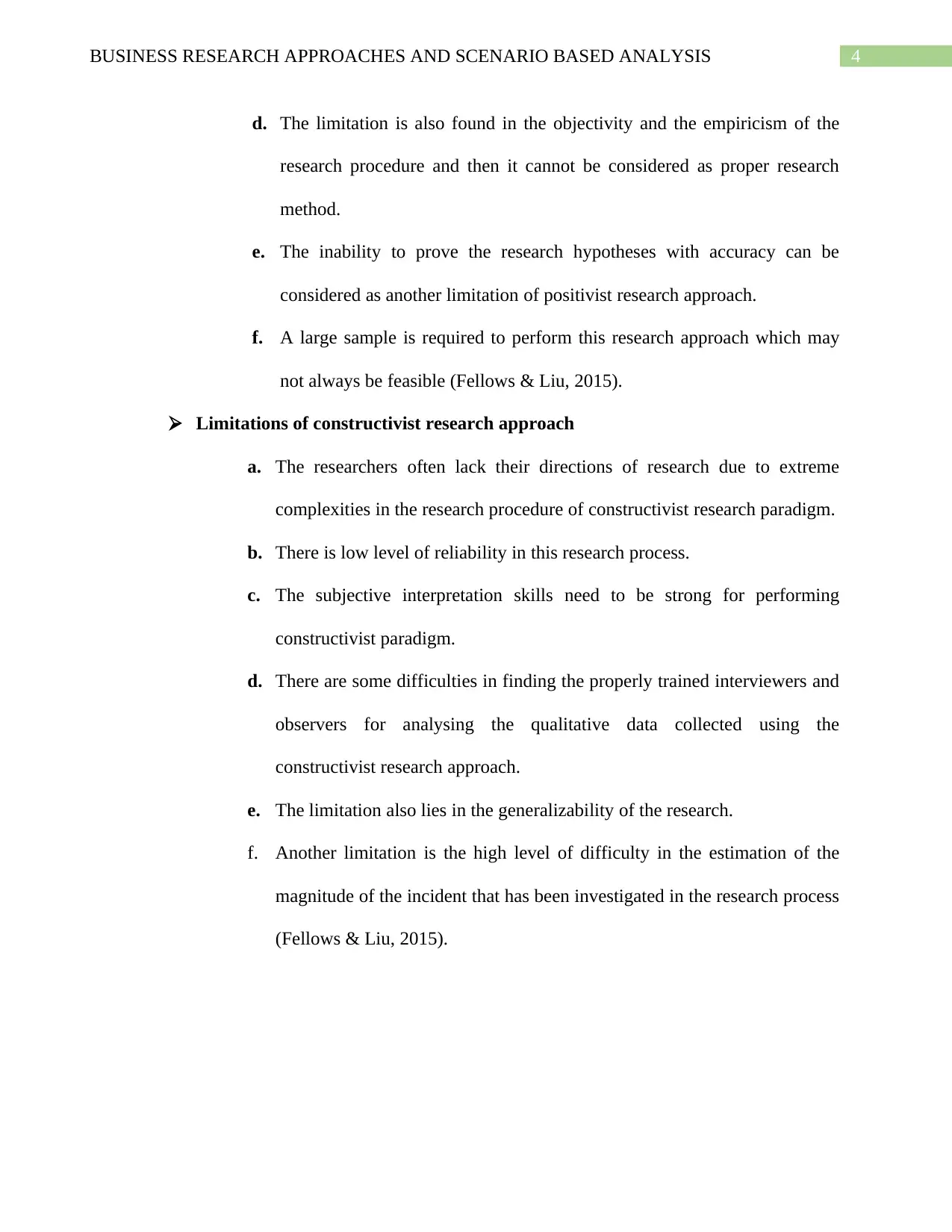
4BUSINESS RESEARCH APPROACHES AND SCENARIO BASED ANALYSIS
d. The limitation is also found in the objectivity and the empiricism of the
research procedure and then it cannot be considered as proper research
method.
e. The inability to prove the research hypotheses with accuracy can be
considered as another limitation of positivist research approach.
f. A large sample is required to perform this research approach which may
not always be feasible (Fellows & Liu, 2015).
Limitations of constructivist research approach
a. The researchers often lack their directions of research due to extreme
complexities in the research procedure of constructivist research paradigm.
b. There is low level of reliability in this research process.
c. The subjective interpretation skills need to be strong for performing
constructivist paradigm.
d. There are some difficulties in finding the properly trained interviewers and
observers for analysing the qualitative data collected using the
constructivist research approach.
e. The limitation also lies in the generalizability of the research.
f. Another limitation is the high level of difficulty in the estimation of the
magnitude of the incident that has been investigated in the research process
(Fellows & Liu, 2015).
d. The limitation is also found in the objectivity and the empiricism of the
research procedure and then it cannot be considered as proper research
method.
e. The inability to prove the research hypotheses with accuracy can be
considered as another limitation of positivist research approach.
f. A large sample is required to perform this research approach which may
not always be feasible (Fellows & Liu, 2015).
Limitations of constructivist research approach
a. The researchers often lack their directions of research due to extreme
complexities in the research procedure of constructivist research paradigm.
b. There is low level of reliability in this research process.
c. The subjective interpretation skills need to be strong for performing
constructivist paradigm.
d. There are some difficulties in finding the properly trained interviewers and
observers for analysing the qualitative data collected using the
constructivist research approach.
e. The limitation also lies in the generalizability of the research.
f. Another limitation is the high level of difficulty in the estimation of the
magnitude of the incident that has been investigated in the research process
(Fellows & Liu, 2015).
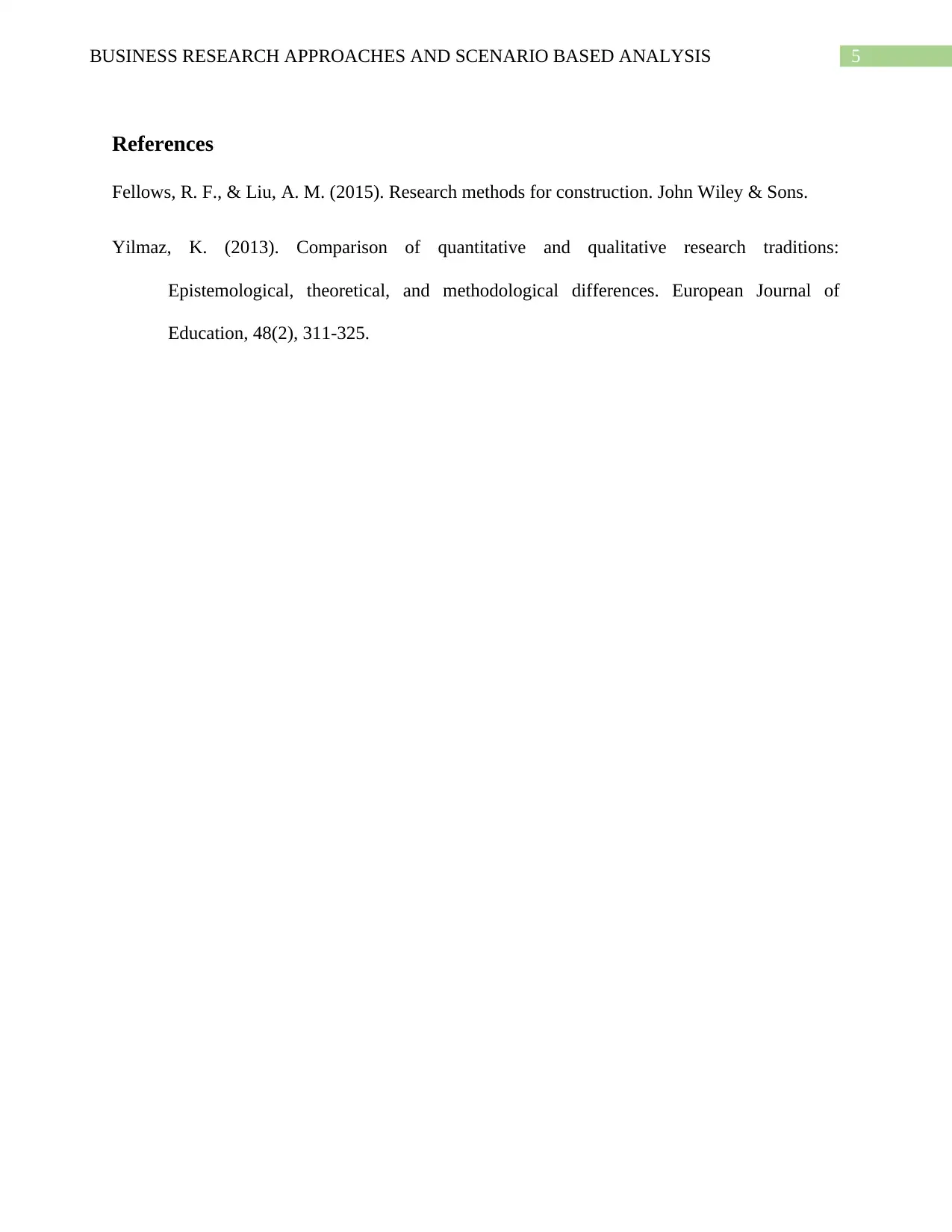
5BUSINESS RESEARCH APPROACHES AND SCENARIO BASED ANALYSIS
References
Fellows, R. F., & Liu, A. M. (2015). Research methods for construction. John Wiley & Sons.
Yilmaz, K. (2013). Comparison of quantitative and qualitative research traditions:
Epistemological, theoretical, and methodological differences. European Journal of
Education, 48(2), 311-325.
References
Fellows, R. F., & Liu, A. M. (2015). Research methods for construction. John Wiley & Sons.
Yilmaz, K. (2013). Comparison of quantitative and qualitative research traditions:
Epistemological, theoretical, and methodological differences. European Journal of
Education, 48(2), 311-325.
1 out of 6
Your All-in-One AI-Powered Toolkit for Academic Success.
+13062052269
info@desklib.com
Available 24*7 on WhatsApp / Email
![[object Object]](/_next/static/media/star-bottom.7253800d.svg)
Unlock your academic potential
© 2024 | Zucol Services PVT LTD | All rights reserved.

